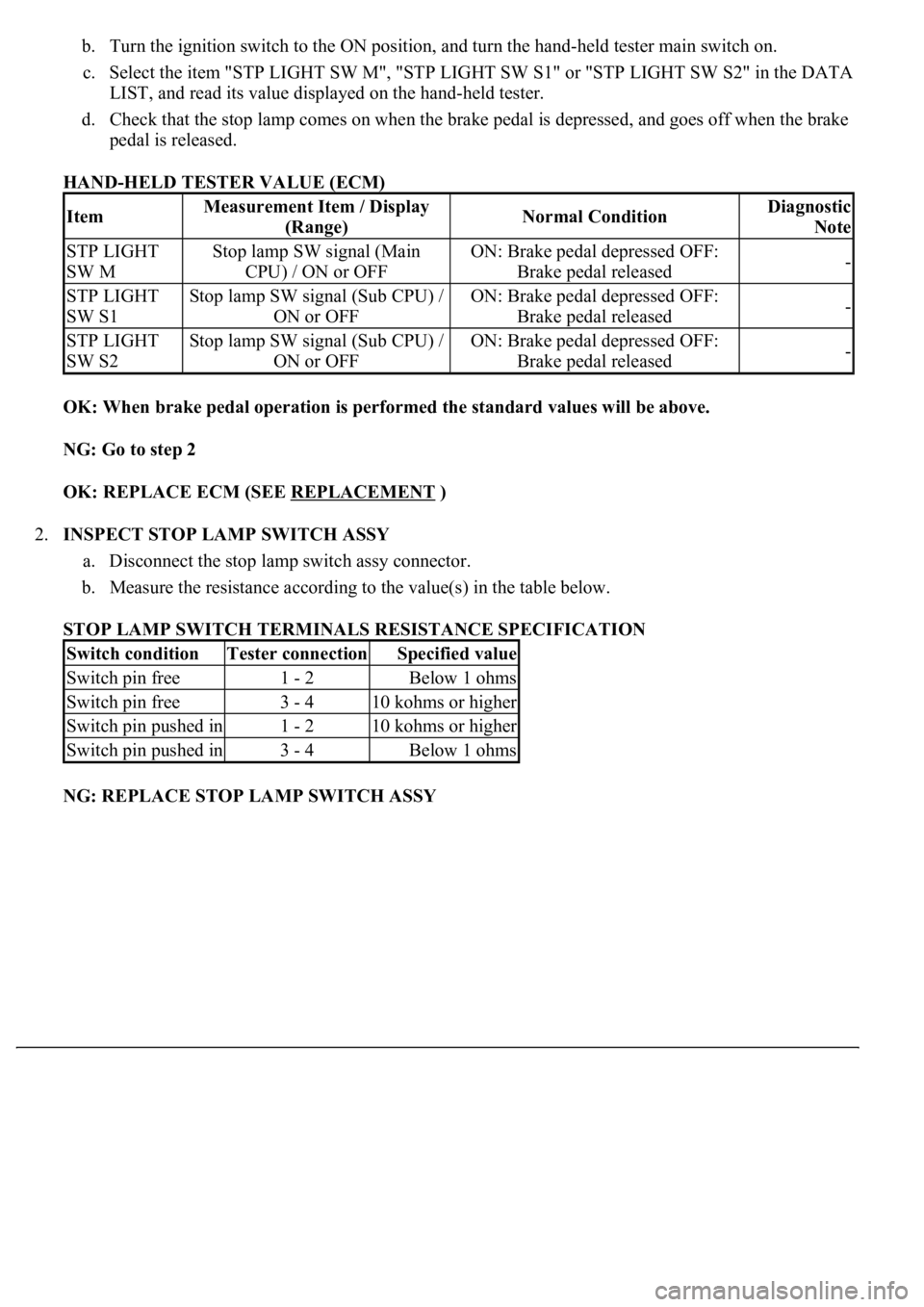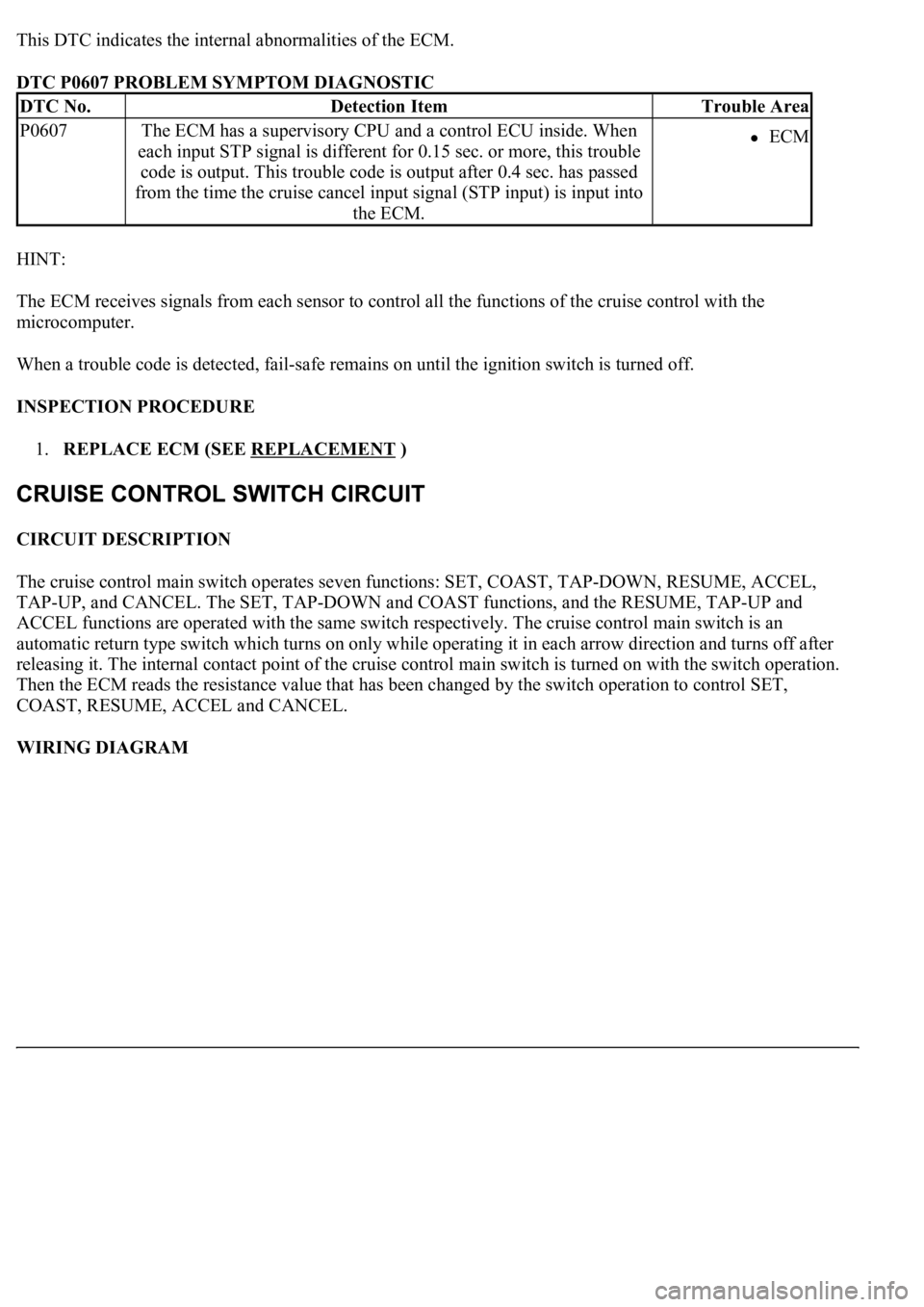Page 1925 of 4500

b. Turn the ignition switch to the ON position, and turn the hand-held tester main switch on.
c. Select the item "STP LIGHT SW M", "STP LIGHT SW S1" or "STP LIGHT SW S2" in the DATA
LIST, and read its value displayed on the hand-held tester.
d. Check that the stop lamp comes on when the brake pedal is depressed, and goes off when the brake
pedal is released.
HAND-HELD TESTER VALUE (ECM)
OK: When brake pedal operation is performed the standard values will be above.
NG: Go to step 2
OK: REPLACE ECM (SEE REPLACEMENT
)
2.INSPECT STOP LAMP SWITCH ASSY
a. Disconnect the stop lamp switch assy connector.
b. Measure the resistance according to the value(s) in the table below.
STOP LAMP SWITCH TERMINALS RESISTANCE SPECIFICATION
NG: REPLACE STOP LAMP SWITCH ASSY
ItemMeasurement Item / Display
(Range)Normal ConditionDiagnostic
Note
STP LIGHT
SW MStop lamp SW signal (Main
CPU) / ON or OFFON: Brake pedal depressed OFF:
Brake pedal released-
STP LIGHT
SW S1Stop lamp SW signal (Sub CPU) /
ON or OFFON: Brake pedal depressed OFF:
Brake pedal released-
STP LIGHT
SW S2Stop lamp SW signal (Sub CPU) /
ON or OFFON: Brake pedal depressed OFF:
Brake pedal released-
Switch conditionTester connectionSpecified value
Switch pin free1 - 2Below 1 ohms
Switch pin free3 - 410 kohms or higher
Switch pin pushed in1 - 210 kohms or higher
Switch pin pushed in3 - 4Below 1 ohms
Page 1927 of 4500
Fig. 22: Identifying Stop Lamp Switch Connector
Courtesy of TOYOTA MOTOR SALES, U.S.A., INC.
OK: Go to next step
4.INSPECT ECM
a. Reconnect the stop lamp switch connector.
b. Disconnect the E2 and E3 connectors from the ECM.
c. Turn the ignition switch to the ON position.
d. Measure the voltage according to the value(s) in the table below.
ECM CONNECTOR TERMINALS VOLTAGE RESISTANCE SPECIFICATION
RESULT DETAIL
Pedal conditionTester connectionSpecification
DepressedE2-4 (STP) - Body ground10 to 14 V
ReleasedE2-4 (STP) - Body groundBelow 1 V
DepressedE3-8 (ST1-) - Body groundBelow 1 V
ReleasedE3-8 (ST1-) - Body ground10 to 14 V
Page 1928 of 4500
B: Go to step 5
C: REPAIR OR REPLACE HARNESS OR CONNECTOR (STOP LAMP SWITCH - ECM)
OKA
NG (STP terminal is NG)B
NG (ST1- terminals is NG)C
Page 1930 of 4500
Courtesy of TOYOTA MOTOR SALES, U.S.A., INC.
A: REPLACE ECM (SEE REPLACEMENT
)
5.INSPECT DRIVER SIDE J/B
a. Measure the voltage according to the value(s) in the table below.
Fig. 24: Identifying Driver Side Junction Block ECU Connectors
Courtesy of TOYOTA MOTOR SALES, U.S.A., INC.
DRIVER SIDE JUNCTION BLOCK ECU TERMINALS VOLTAGE SPECIFICATION
NG: Go to step 6
OK: REPAIR OR REPLACE HARNESS OR CONNECTOR (DRIVER SIDE J/B ECU - ECM)
6.INSPECT DRIVER SIDE J/B
Pedal conditionTester connectionSpecification
DepressedD3-12 (STPO) - Body ground10 to 14 V
ReleasedD3-12 (STPO) - Body groundBelow 1 V
Page 1932 of 4500

This DTC indicates the internal abnormalities of the ECM.
DTC P0607 PROBLEM SYMPTOM DIAGNOSTIC
HINT:
The ECM receives signals from each sensor to control all the functions of the cruise control with the
microcomputer.
When a trouble code is detected, fail-safe remains on until the ignition switch is turned off.
INSPECTION PROCEDURE
1.REPLACE ECM (SEE REPLACEMENT
)
CIRCUIT DESCRIPTION
The cruise control main switch operates seven functions: SET, COAST, TAP-DOWN, RESUME, ACCEL,
TAP-UP, and CANCEL. The SET, TAP-DOWN and COAST functions, and the RESUME, TAP-UP and
ACCEL functions are operated with the same switch respectively. The cruise control main switch is an
automatic return type switch which turns on only while operating it in each arrow direction and turns off after
releasing it. The internal contact point of the cruise control main switch is turned on with the switch operation.
Then the ECM reads the resistance value that has been changed by the switch operation to control SET,
COAST, RESUME, ACCEL and CANCEL.
WIRING DIAGRAM
DTC No.Detection ItemTrouble Area
P0607The ECM has a supervisory CPU and a control ECU inside. When
each input STP signal is different for 0.15 sec. or more, this trouble
code is output. This trouble code is output after 0.4 sec. has passed
from the time the cruise cancel input signal (STP input) is input into
the ECM.ECM
Page 1934 of 4500
Fig. 27: Identifying Cruise Control Main Switch Positions
Courtesy of TOYOTA MOTOR SALES, U.S.A., INC.
HAND-HELD TESTER VALUE (ECM)
OK: When cruise control main switch operation is performed the standard values will be above.
RESULT DETAIL
Item
Measurement Item /
Display (Range)
Normal ConditionDiagnostic Note
MAIN SW (MAIN)Main SW signal (Main
CPU) / ON or OFFON: Main SW ON (Pushed on)
OFF Main SW OFF (Pushed off)-
MAIN SW (SUB)Main SW signal (Main
CPU) / ON or OFFON: Main SW ON (Pushed on)
OFF Main SW OFF (Pushed off)-
CANCEL SWCANCEL SW signal / ON or
OFFON: CANCEL SW ON OFF:
CANCEL SW OFF-
SET/COAST SWSET/COAST SW signal / ON
or OFFON: SET/COAST SW ON OFF:
SET/COAST SW OFF-
RES/ACC SWRES/ACC SW signal / ON or
OFFON: RES/ACC SW ON OFF:
RES/ACC OFF-
Page 1938 of 4500
OK: Go to next step
4.CHECK HARNESS AND CONNECTOR (SPIRAL CABLE SUB-ASSY - ECM, BODY GROUND)
a. Measure the resistance according to the value(s) in the table below.
SPIRAL CABLE CONNECTOR TERMINALS RESISTANCE SPECIFICATION
<0029004c004a0011000300160013001d0003002c0047004800510057004c0049005c004c0051004a000300360053004c00550044004f0003002600440045004f0048000300260052005100510048004600570052005500030037004800550050004c005100
44004f0056[
Courtesy of TOYOTA MOTOR SALES, U.S.A., INC.
Tester connectionConditionSpecification
Spiral cable (C13-2) - CCS (E2-31)AlwaysBelow 1 ohms
CCS (E2-31) - Body groundAlways10 kohms or higher
Spiral cable (C13-3) - Body groundAlwaysBelow 1 ohms
Page 1940 of 4500
![LEXUS LS430 2003 Factory Repair Manual Fig. 31: [Disconnecting ECM Connector]
Courtesy of TOYOTA MOTOR SALES, U.S.A., INC.
NG: REPAIR OR REPLACE HARNESS OR CONNECTOR
OK: REPLACE ECM (SEE REPLACEMENT
)
CIRCUIT DESCRIPTION
The ECM det LEXUS LS430 2003 Factory Repair Manual Fig. 31: [Disconnecting ECM Connector]
Courtesy of TOYOTA MOTOR SALES, U.S.A., INC.
NG: REPAIR OR REPLACE HARNESS OR CONNECTOR
OK: REPLACE ECM (SEE REPLACEMENT
)
CIRCUIT DESCRIPTION
The ECM det](/manual-img/36/57050/w960_57050-1939.png)
Fig. 31: [Disconnecting ECM Connector]
Courtesy of TOYOTA MOTOR SALES, U.S.A., INC.
NG: REPAIR OR REPLACE HARNESS OR CONNECTOR
OK: REPLACE ECM (SEE REPLACEMENT
)
CIRCUIT DESCRIPTION
The ECM detects a cruise control switch signal and sends it to the combination meter via CAN and
BEAN. Then the CRUISE main indicator light comes on.
The CRUISE main indicator light circuit uses CAN and BEAN for communication. If there are any
malfunctions in this circuit, check for DTCs in the CAN communication system and multiplex
communication system.
INSPECTION PROCEDURE
1.PERFORM ACTIVE TEST BY HAND-HELD TESTER
a. Connect the hand-held tester to the DLC3.
b. Check the CRUISE main indicator light by using ACTIVE TEST.
ACTIVE TEST DETAIL (COMBINATION METER ASSY)
OK: Indicator light comes on/goes off.
NG: GO TO COMBINATION METER SYSTEM (SEE HOW TO PROCEED WITH
TROUBLESHOOTING )
OK: Go to next step
2.READ VALUE ON HAND-HELD TESTER
a. Connect the hand-held tester to the DLC3.
b. Turn the ignition switch to the ON position and turn the hand-held tester main switch on.
c. Select the item below in the "DATA LIST", and read the display on the hand-held tester.
DATA LIST (CC (ECM))
ItemVehicle Condition / Test DetailsDiagnostic Note
CRUISE INDIC"CRUISE" indicator is ON / OFF-
ItemMeasurement Item / Display
(Range)Normal ConditionDiagnostic
Note
CCS INDICATOR
MCruise indicator signal (Main
CPU) /ON or OFFON: "CCS READY" ON OFF:
"CCS READY" OFF-